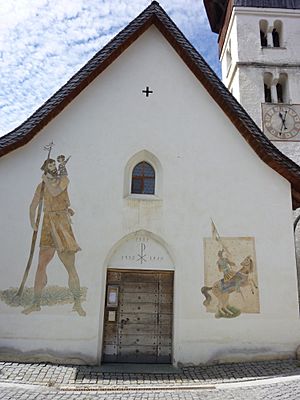Alois Carigiet facts for kids

Alois Carigiet (born August 30, 1902 – died August 1, 1985) was a Swiss artist. He was a graphic designer, painter, and illustrator. He is most famous for his six children's picture books set in the Alps. These include A Bell for Ursli and its follow-up stories. Some books were written by Selina Chönz, and he wrote three himself. In 1966, he won the first Hans Christian Andersen Medal for children's illustrators. This is a very important award for children's books.
Contents
Biography
Growing Up and Learning (1902 – 1923)
Alois Carigiet was one of eleven children. His family lived on a farm in Trun in Switzerland. His younger brother, Zarli Carigiet, became a famous actor. Alois grew up speaking Sursilvan, a local language.
In 1911, his family faced tough times. They had to move to Chur, a bigger city. Alois was nine years old. He felt like he was leaving a "mountain boy's paradise" for a "gloomy apartment."
Alois went to school in Chur. In 1918, he started an apprenticeship. He learned to be a decorative designer. He learned skills like painting and gold plating. Alois spent a lot of time drawing in his sketchbooks. He drew animals, people, and scenes from nature. His teacher noticed his great talent. Alois finished his training in 1923 with top grades.
Working as a Graphic Designer in Zurich (1923 – 1939)
After his training, Carigiet moved to Zurich. He started working at an advertising agency in 1923. He quickly learned about graphic design. This means creating visual things like posters and ads. He soon became a full-time employee.
Carigiet won several design contests. He became well-known. In 1927, he opened his own graphic design studio in Zurich. He often had many orders. He created many different things. These included posters for businesses and politics. He also made decorations for festivals. He drew illustrations and funny pictures for magazines. He designed covers for publications like Schweizer Spiegel.
In the 1930s, he did important work. He created a special display for the Swiss part of the Paris International world fair in 1937. He also designed sets and posters for the "Landi." This was a big Swiss national exhibition in Zurich in 1939.
Life in Platenga (1939 – 1950)
In May 1939, Carigiet visited Trun for a holiday. He hiked to a small village called Platenga. He loved the wide, untouched landscape there. He felt like he had found a lost paradise.
He decided to close his business in Zurich. In October 1939, he rented a small farmhouse in Platenga. It had no electricity or running water. Carigiet wanted to focus on his art and observing nature. He spent hours watching alpine animals and sketching them.
On April 20, 1943, Carigiet married Berta Carolina Müller. She was an art student. Their first daughter was born in 1944. In 1945, Carigiet designed a bigger house. It was built in 1946. Their second daughter was born there in 1947. The house was called "Im Sunnefang." In 1950, the family moved back to Zurich. They did this mainly for the girls' education. Carigiet started his graphic design work again. But he also kept creating his art.
His Famous Children's Books
In 1940, a writer named Selina Chönz asked Carigiet for help. She wanted him to illustrate her story "Uorsin." It took several years, but Carigiet finally agreed. He spent weeks sketching in Guarda. This was Chönz's home village. He used it as the model for the village in the book.
In October 1945, the book was published in German. It was called Uorsin (Schellen-Ursli. Ein Engadiner Bilderbuch). Later, it came out in English as A Bell for Ursli (1950). The story is about a boy named Ursli. He makes a dangerous climb through snow. He wants to get a large bell for the annual Chalandamarz celebration. This celebration happens on March 1st. The book has been translated into ten languages. About 1.7 million copies have been sold worldwide. Art critics praised Carigiet's colorful and exciting pictures.
Carigiet and Chönz made more Alpine children's books. Two more stories featured Ursli's younger sister. These were Flurina (1952), known as Florina and the Wild Bird in English. The other was La naivera (1957), or The Snowstorm.
In the 1960s, Carigiet started writing and illustrating his own books. These included:
- Zottel, Zick und Zwerg (1965), which means Anton the Goatherd.
- Birnbaum, Birke, Berberitze (1967), or The Pear Tree, the Birch Tree and the Barberry Bush.
- Maurus und Madleina (1969), or Anton and Anne.
In 1966, he won the Swiss Youth Book Prize for Zottel, Zick und Zwerg.
The Hans Christian Andersen Award is a very important award. It is given to the best children's book writers or illustrators. Carigiet received the first award for illustrators in 1966.
Later Years (1960 – 1985)
In 1960, Carigiet bought a house called "Flutginas." It was above Trun, his childhood village. He spent the rest of his life there, focusing on painting. In 1962, he gave a speech in Zurich. He called his art "narrative art." This means it tells stories. He said Georges Rouault was a big inspiration for him.
Until 1982, he often showed his artwork. He had exhibitions in Switzerland. He also showed his art in Toronto (1969) and Frankfurt (1971). Alois Carigiet passed away on August 1, 1985, in Trun.
Images for kids
-
Carigiet murals on the Catholic Church in Vella, Switzerland, showing Saint Christopher and Saint Maurice (1940)


